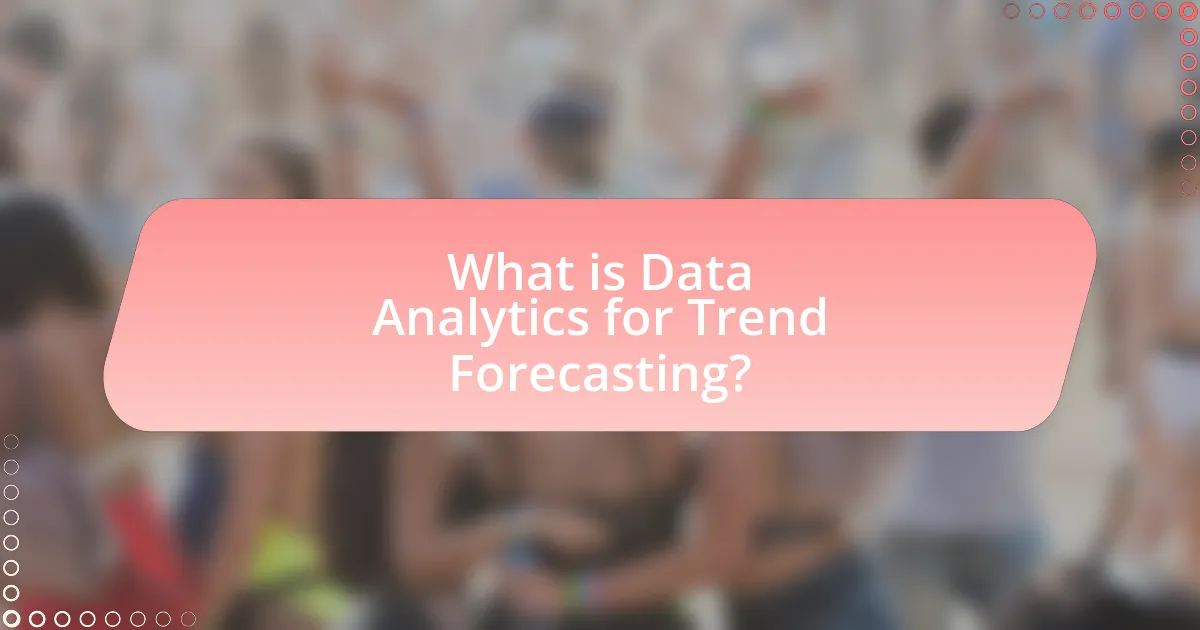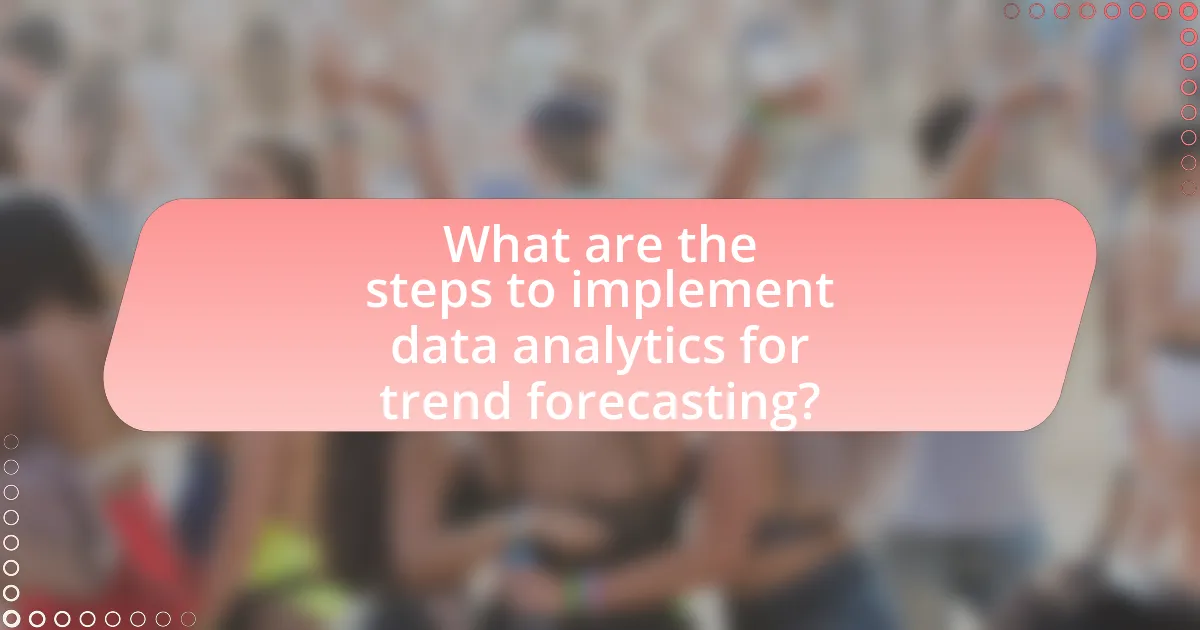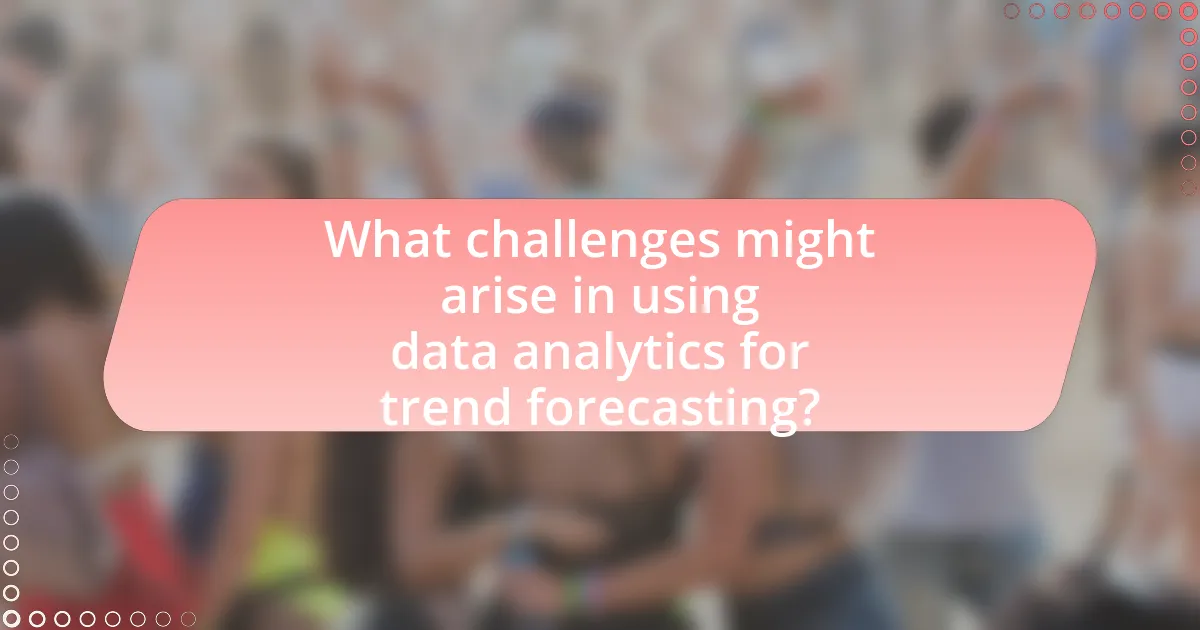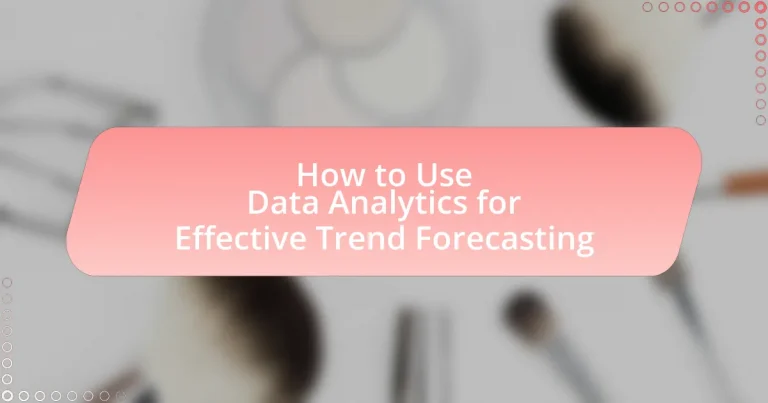Data analytics for trend forecasting involves utilizing statistical techniques and algorithms to analyze historical data and predict future market behaviors. This article outlines the significance of data analytics in enhancing forecasting accuracy, highlighting key techniques such as time series analysis, regression analysis, and machine learning algorithms. It discusses the impact of data quality on forecasting outcomes, the importance of effective trend forecasting for strategic business decisions, and the potential consequences of inaccurate predictions. Additionally, the article addresses challenges in data analytics, ethical considerations, and best practices for implementing effective trend forecasting strategies.

What is Data Analytics for Trend Forecasting?
Data analytics for trend forecasting is the process of using statistical techniques and algorithms to analyze historical data and predict future trends. This approach leverages large datasets to identify patterns, correlations, and anomalies, enabling organizations to make informed decisions based on projected market behaviors. For instance, a study by McKinsey & Company highlights that companies using data analytics for forecasting can improve their accuracy by up to 50%, demonstrating the effectiveness of this method in anticipating consumer demand and market shifts.
How does data analytics contribute to trend forecasting?
Data analytics significantly enhances trend forecasting by enabling organizations to analyze historical data and identify patterns that predict future behaviors. By employing statistical methods and machine learning algorithms, data analytics processes large datasets to uncover insights that inform decision-making. For instance, a study by McKinsey & Company found that companies using advanced analytics are 5 times more likely to make faster decisions than their competitors. This capability allows businesses to anticipate market shifts, optimize inventory, and tailor marketing strategies effectively, ultimately leading to improved performance and competitive advantage.
What are the key techniques used in data analytics for trend forecasting?
Key techniques used in data analytics for trend forecasting include time series analysis, regression analysis, and machine learning algorithms. Time series analysis involves examining historical data points to identify patterns and trends over time, which is essential for predicting future values. Regression analysis quantifies the relationship between variables, allowing analysts to forecast trends based on independent factors. Machine learning algorithms, such as neural networks and decision trees, enhance forecasting accuracy by learning from complex datasets and adapting to new information. These techniques are validated by their widespread application in industries like finance and retail, where accurate trend forecasting is crucial for decision-making and strategy development.
How do data sources impact the accuracy of trend forecasting?
Data sources significantly impact the accuracy of trend forecasting by determining the quality and relevance of the information used for analysis. High-quality data sources, such as verified historical datasets and real-time analytics, provide accurate insights that enhance predictive models. For instance, a study by the McKinsey Global Institute found that organizations using high-quality data sources can improve forecasting accuracy by up to 20%. Conversely, unreliable or outdated data can lead to erroneous predictions, as seen in cases where businesses relied on incomplete datasets, resulting in misguided strategic decisions. Thus, the selection and management of data sources are crucial for achieving reliable trend forecasts.
Why is trend forecasting important for businesses?
Trend forecasting is important for businesses because it enables them to anticipate market changes and consumer preferences, allowing for strategic planning and resource allocation. By analyzing historical data and current trends, businesses can identify potential opportunities and threats, which enhances decision-making processes. For instance, a study by McKinsey & Company found that companies that effectively use data analytics for trend forecasting can achieve a 20% increase in revenue compared to their competitors. This demonstrates that accurate trend forecasting not only supports innovation but also drives competitive advantage in rapidly changing markets.
What are the potential consequences of inaccurate trend forecasting?
Inaccurate trend forecasting can lead to significant financial losses for businesses. When companies misinterpret market trends, they may overproduce or underproduce goods, resulting in excess inventory or stock shortages. For instance, a study by McKinsey & Company found that companies with poor demand forecasting can experience a 10% increase in costs and a 20% decrease in revenue. Additionally, inaccurate forecasts can damage brand reputation, as customers may become dissatisfied with product availability or quality. This misalignment with consumer expectations can ultimately lead to a loss of market share and reduced competitiveness.
How can effective trend forecasting enhance decision-making?
Effective trend forecasting enhances decision-making by providing organizations with data-driven insights that inform strategic planning and resource allocation. By analyzing historical data and identifying patterns, businesses can anticipate market shifts, consumer preferences, and potential risks. For instance, a study by McKinsey & Company found that companies using advanced analytics for trend forecasting can improve their decision-making speed by 5 to 10 times compared to those relying on traditional methods. This capability allows organizations to adapt proactively, optimize operations, and ultimately gain a competitive advantage in their respective markets.

What are the steps to implement data analytics for trend forecasting?
To implement data analytics for trend forecasting, follow these steps: first, define the objectives and key performance indicators (KPIs) that will guide the analysis. Next, collect relevant data from various sources, ensuring it is clean and structured. After data collection, utilize analytical tools and techniques, such as statistical analysis and machine learning algorithms, to identify patterns and trends. Subsequently, visualize the results using dashboards or reports to facilitate understanding and decision-making. Finally, continuously monitor and refine the forecasting model based on new data and feedback to improve accuracy over time. These steps are essential for leveraging data analytics effectively in trend forecasting.
How do you collect and prepare data for analysis?
To collect and prepare data for analysis, one must first identify relevant data sources, such as databases, surveys, or web scraping tools. After identifying sources, data is gathered systematically, ensuring accuracy and completeness. Data cleaning follows, which involves removing duplicates, correcting errors, and handling missing values to enhance data quality. For instance, a study by Kelleher and Tierney (2018) emphasizes the importance of data cleaning in improving predictive model performance. Finally, data is transformed into a suitable format for analysis, often involving normalization or aggregation, to facilitate effective trend forecasting.
What tools are available for data collection and preparation?
Tools available for data collection and preparation include software such as Microsoft Excel, Google Sheets, and specialized platforms like Alteryx and Tableau. Microsoft Excel and Google Sheets are widely used for data entry, manipulation, and basic analysis due to their user-friendly interfaces and functionalities. Alteryx offers advanced data preparation capabilities, allowing users to blend data from various sources efficiently. Tableau, primarily known for data visualization, also provides data preparation tools that help in cleaning and organizing data before analysis. These tools are essential for ensuring data quality and readiness for effective trend forecasting in data analytics.
How can data cleaning improve forecasting results?
Data cleaning significantly improves forecasting results by ensuring the accuracy and reliability of the data used in predictive models. Clean data eliminates errors, inconsistencies, and outliers that can distort analysis, leading to more precise forecasts. For instance, a study by the Harvard Business Review found that organizations that prioritize data quality can achieve up to 20% better forecasting accuracy. By removing duplicates and correcting inaccuracies, data cleaning enhances the model’s ability to identify trends and patterns, ultimately resulting in more informed decision-making and strategic planning.
What analytical methods can be applied to forecast trends?
Analytical methods that can be applied to forecast trends include time series analysis, regression analysis, and machine learning algorithms. Time series analysis involves examining historical data points to identify patterns and predict future values, which is supported by its widespread use in economic forecasting. Regression analysis establishes relationships between variables, allowing for predictions based on identified trends, as evidenced by its application in various fields such as finance and marketing. Machine learning algorithms, such as neural networks and decision trees, enhance forecasting accuracy by learning from large datasets and adapting to new information, demonstrated by their effectiveness in sectors like retail and healthcare.
How do statistical models differ from machine learning approaches in trend forecasting?
Statistical models differ from machine learning approaches in trend forecasting primarily in their methodology and underlying assumptions. Statistical models, such as linear regression, rely on predefined equations and assume a specific relationship between variables, often requiring the data to meet certain statistical assumptions like normality and homoscedasticity. In contrast, machine learning approaches, such as neural networks or decision trees, utilize algorithms that can learn complex patterns from data without strict assumptions about the underlying distribution, allowing for greater flexibility and adaptability to non-linear relationships.
For example, a study published in the Journal of Forecasting by Hyndman and Athanasopoulos (2018) highlights that statistical models are often easier to interpret and provide insights into the relationships between variables, while machine learning models excel in handling large datasets and capturing intricate patterns that may not be evident through traditional statistical methods. This distinction underscores the importance of selecting the appropriate approach based on the specific forecasting context and data characteristics.
What role does visualization play in understanding trends?
Visualization plays a crucial role in understanding trends by transforming complex data into accessible graphical formats that highlight patterns and insights. This graphical representation allows analysts and decision-makers to quickly identify correlations, anomalies, and shifts in data over time, facilitating informed decision-making. For instance, studies show that visual data can improve comprehension by up to 400% compared to raw data, as it leverages human cognitive abilities to process visual information more efficiently.

What challenges might arise in using data analytics for trend forecasting?
Challenges in using data analytics for trend forecasting include data quality issues, complexity in data integration, and the need for skilled personnel. Data quality issues arise when datasets contain inaccuracies or inconsistencies, leading to unreliable forecasts. Complexity in data integration occurs when combining data from various sources, which can result in compatibility problems and hinder analysis. Additionally, the need for skilled personnel is critical, as a lack of expertise in data analytics can limit the ability to interpret results effectively. According to a report by McKinsey, 60% of organizations struggle with data quality, highlighting the prevalence of this challenge in trend forecasting.
How can data quality issues affect forecasting accuracy?
Data quality issues can significantly reduce forecasting accuracy by introducing errors, inconsistencies, and biases into the data used for predictions. When data is inaccurate or incomplete, models may generate misleading forecasts, leading to poor decision-making. For instance, a study by Redman (2018) highlights that organizations with high data quality can improve forecasting accuracy by up to 30%, while those with poor data quality face increased risks of erroneous predictions. This demonstrates that maintaining high data quality is essential for reliable forecasting outcomes.
What strategies can mitigate the impact of poor data quality?
Implementing data validation techniques is a key strategy to mitigate the impact of poor data quality. Data validation ensures that the data entered into systems meets predefined criteria, reducing errors at the source. For instance, using automated checks can identify inconsistencies or inaccuracies in real-time, which is crucial for maintaining data integrity. Additionally, regular data cleansing processes, such as deduplication and standardization, help maintain high-quality datasets. According to a study by Gartner, organizations that prioritize data quality can improve their decision-making processes by up to 70%, demonstrating the tangible benefits of these strategies.
How do external factors influence trend forecasting outcomes?
External factors significantly influence trend forecasting outcomes by introducing variables that can alter consumer behavior, market dynamics, and economic conditions. For instance, changes in government policies, such as tax reforms or trade tariffs, can shift market demand and supply, impacting forecasts. Additionally, social factors like cultural shifts or demographic changes can lead to new consumer preferences, which must be accounted for in trend analysis. Economic indicators, such as inflation rates or unemployment levels, also play a crucial role; they can affect purchasing power and spending habits, thereby influencing the accuracy of forecasts. Historical data shows that during economic downturns, consumer spending typically declines, which can lead to underestimations in demand forecasts if not properly adjusted for these external influences.
What ethical considerations should be taken into account?
Ethical considerations in data analytics for trend forecasting include data privacy, informed consent, and algorithmic bias. Data privacy mandates that organizations protect personal information and comply with regulations such as GDPR, which imposes strict guidelines on data collection and usage. Informed consent requires that individuals understand how their data will be used, ensuring transparency and trust. Algorithmic bias can lead to unfair outcomes, necessitating regular audits of algorithms to ensure they do not perpetuate discrimination. These considerations are crucial for maintaining ethical standards and fostering public trust in data-driven decision-making.
How can data privacy concerns affect data analytics practices?
Data privacy concerns can significantly limit data analytics practices by imposing restrictions on data collection, storage, and usage. Organizations may face legal obligations under regulations such as the General Data Protection Regulation (GDPR), which mandates explicit consent from individuals before processing their personal data. This can lead to reduced data availability, as companies may opt to anonymize or aggregate data to comply with privacy laws, potentially diminishing the granularity and accuracy of analytics insights. Furthermore, heightened consumer awareness of privacy issues can result in decreased trust, prompting organizations to adopt more stringent data governance policies, which can slow down the analytics process and increase operational costs.
What are the implications of biased data on trend forecasting?
Biased data significantly undermines the accuracy of trend forecasting by leading to incorrect predictions and misinformed decision-making. When data is skewed, it can result in models that reflect the biases present in the dataset, causing forecasts to favor certain outcomes while neglecting others. For instance, a study by the MIT Media Lab found that algorithms trained on biased datasets can perpetuate existing inequalities, as seen in predictive policing models that disproportionately target specific communities. This highlights that reliance on biased data can distort insights, ultimately affecting business strategies and resource allocation.
What best practices should be followed for effective trend forecasting?
Effective trend forecasting requires the integration of data analytics, historical data analysis, and continuous monitoring of market changes. Utilizing advanced analytical tools allows organizations to identify patterns and correlations in data, which enhances predictive accuracy. For instance, companies that leverage machine learning algorithms can analyze vast datasets to uncover emerging trends, as evidenced by a McKinsey report indicating that data-driven organizations are 23 times more likely to acquire customers. Additionally, incorporating qualitative insights from industry experts can complement quantitative data, providing a holistic view of potential trends. Regularly updating forecasting models based on real-time data ensures adaptability to market fluctuations, further solidifying the reliability of trend predictions.
How can continuous monitoring improve forecasting accuracy?
Continuous monitoring enhances forecasting accuracy by providing real-time data that reflects current conditions and trends. This immediate access to updated information allows organizations to adjust their forecasts dynamically, improving their responsiveness to changes in the market or environment. For instance, a study by McKinsey & Company found that companies utilizing real-time data analytics can improve their forecasting accuracy by up to 20%, as they can quickly identify and react to emerging patterns. This proactive approach minimizes the reliance on outdated data, thereby increasing the reliability of predictions and decision-making processes.
What role does collaboration play in enhancing forecasting efforts?
Collaboration significantly enhances forecasting efforts by integrating diverse perspectives and expertise, which leads to more accurate predictions. When teams from different departments, such as sales, marketing, and finance, work together, they can share valuable insights and data that improve the overall understanding of market trends. For instance, a study by McKinsey & Company found that organizations with cross-functional collaboration in their forecasting processes achieved up to 20% higher accuracy in their predictions compared to those that operated in silos. This collaborative approach not only enriches the data pool but also fosters a culture of shared responsibility, ultimately resulting in more reliable and actionable forecasts.


